Title: Real estate developer
Birthdate: November, 1862
Death Date: August 30, 1915
Plot Location: Section 208, Lot 90

Sam’s father, Samuel T. Cord, was born in Indiana. His mother, Phoebe Elizabeth Fithian, was born in Georgia, but her parents were born in New Jersey. That’s where Samuel and Phoebe had their first daughter, in 1858. The other three children, Emma, Sam, and Harry, were born in Philadelphia where the family put down roots and lived in the 600 block of Dickinson Street for 40 years.
As Sam grew up, his father was a newspaper clerk, then sold newspaper advertising. He also dabbled in real estate before he died in 1898, and sales became Sam’s strong suit as well. By 1888 he was employed by Magnolia Villa Land & Improvement Company of New Jersey to sell lots in what is now the borough of Magnolia. It was being developed along the White Horse Pike (today’s U.S. Route 30), originally a toll road between Camden and the town of Stratford.
What spurred even greater development was the introduction of train service by the Philadelphia & Atlantic City Railroad in the 1880s. Today that line that parallels the pike is known as the PATCO High Speed Line, running between Philly and Lindenwold. One of Sam’s greatest strengths was in promoting the commuter lifestyle long before the migration to suburbia became popular.
Laurel Springs
While still working for the Magnolia company, Sam formed a partnership to develop a resort property just three miles south of there in Laurel Springs. It was named for the dozens of clear mineral and sweet water springs situated among laurel groves. The wealthy would stop on their way to Atlantic City to enjoy the therapeutic waters. Among them was poet Walt Whitman, who spent his summers there from 1876-1884.
Sam was 30 when he left his job, bought a farm beside the springs and drew plans for streets and lots in the new community. He was still living with his parents but soon opened a real estate office in Center City. His commitment to his job was then matched by his commitment to marriage with Alice Gigon in 1895.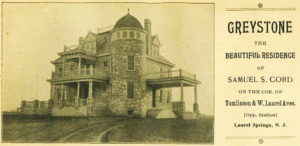
Work then began on their dream home, shown here. Sam even gave it a name and wasn’t shy about using it to promote the new subdivision. He even built it just across the street from the train stop. Living the lifestyle he promoted, he commuted to his office in the city but also had an office in his home. The couple never had children but he thrived in his work and she enjoyed the social life. It was quite a leap from the row house Sam knew from childhood.
He showed his commitment to his new neighbors when he served as Laurel Springs postmaster in 1898-99. Sam was making a lot of money, and spending it too, carrying a mortgage on the home and starting a newspaper, the Laurel Springs Courier. It was basically a promotional gimmick, but he was in competition with two other developers of the little neighborhood.
 Real estate advertising in the Philly newspapers was another major investment, but Sam kept it up for over 20 years with ads like this, even advertising that he had money to loan. Extravagant claims occasionally went too far. One said it was in “the mountains of South Jersey” and “400 feet higher than Camden.” If the statement was that it was four times higher than Camden it would have been correct, although still deceptive. Camden’s elevation is 16 feet; Laurel Springs is 85 feet, but not 416.
Real estate advertising in the Philly newspapers was another major investment, but Sam kept it up for over 20 years with ads like this, even advertising that he had money to loan. Extravagant claims occasionally went too far. One said it was in “the mountains of South Jersey” and “400 feet higher than Camden.” If the statement was that it was four times higher than Camden it would have been correct, although still deceptive. Camden’s elevation is 16 feet; Laurel Springs is 85 feet, but not 416.
Other Ventures
Sam’s business included the sale of properties in Philly like other real estate agents, but his passion was in developing land. He often advertised “wanted to buy” farmland that he hoped to subdivide.
In the late 1890s he added another development to his portfolio, marketing “Cold Springs,” just north of Cape May, “The cool ocean breezes and celebrated spring water quickly restores sick people to perfect health.” The advertising stopped a few years later, suggesting it was a short-lived venture. In an attempt to cut his losses he joined two partners in forming the Cape May Realty Company in 1908.
Sam was in discussions with another partner in 1915 about a vast tract of timberland in Florida. This was about the only provable fact from that year, other than 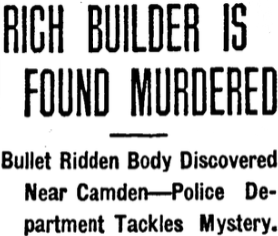 his death from five gunshots on August 30th. His body was found in a ditch in Pennsauken, but not much else is certain.
his death from five gunshots on August 30th. His body was found in a ditch in Pennsauken, but not much else is certain.
Fourteen detectives, aided by Philadelphia police, tracked down dozens of theories that never panned out. Olaf Peterson, Sam’s partner, was grilled about their business dealings, money issues, and every lead they received. He maintained Sam had some involvement with another woman but nothing was substantiated.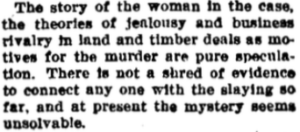 He was held almost 30 days before being released for lack of evidence.
He was held almost 30 days before being released for lack of evidence.
The story of the crime was carried for weeks by newspapers around the country. The case went cold until almost a year later. The story below was published July 14, 1916 after the 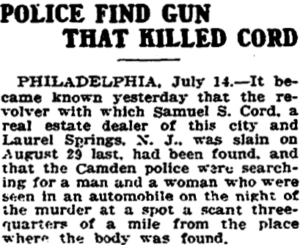 revolver used in the murder was somehow recovered. No suspects were found, however, and the case was never resolved.
revolver used in the murder was somehow recovered. No suspects were found, however, and the case was never resolved.
Alice lived until 1931, spending her last years in a boarding house in Philadelphia. Laurel Springs, which had incorporated in 1913, foreclosed on the mansion and took ownership in 1935. It became the Borough Hall and was expanded to house the Police Department and other municipal offices. A fire station was added in the rear of the property.
Sam was buried here in the same plot as his father who died in 1898 and mother in 1906. His brother Harry also came to a sad end. After a long career with the Philadelphia Police Department, he died from a self-inflicted gunshot wound in 1951. He and his wife are buried here as well. Their son, 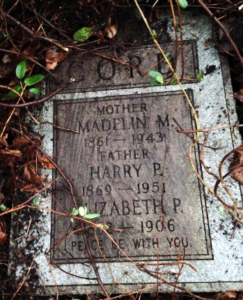 Harry Samuel Cord, purchased this gravestone to honor his mother, father, and grandmother Elizabeth. He and his wife have their own stone in this lot but a marker for Sam and his father have not been located.
Harry Samuel Cord, purchased this gravestone to honor his mother, father, and grandmother Elizabeth. He and his wife have their own stone in this lot but a marker for Sam and his father have not been located.

Support the Friends of Mount Moriah
Help us in our mission to restore and maintain the beautiful Mount Moriah Cemetery by donating to our cause or volunteering at one of our clean-up events.

